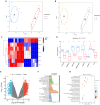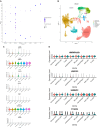N6-methyladenosine methylation regulators can serve as potential biomarkers for endometriosis related infertility
- PMID: 39739380
- PMCID: PMC12097398
- DOI: 10.17305/bb.2024.11311
N6-methyladenosine methylation regulators can serve as potential biomarkers for endometriosis related infertility
Abstract
Endometriosis (EMS) is a chronic inflammatory disease frequently associated with infertility. N6-methyladenosine (m6A) methylation, the most common form of methylation in eukaryotic mRNAs, has gained attention in the study of female reproductive diseases, including EMS and infertility. This study aimed to investigate the role of m6A regulators in EMS-related infertility. To begin, specific m6A regulators were identified by analyzing the GSE120103 dataset, followed by receiver operating characteristic (ROC) curve analysis. A nomogram model was then constructed, and unsupervised clustering of m6A regulators was performed to identify distinct m6A molecular clusters. Functional enrichment analysis of differentially expressed genes (DEGs) between these clusters, along with immune cell infiltration analysis, was subsequently conducted. In addition, the single-cell dataset GSE214411 was analyzed to explore the role of m6A regulators in various cell types. Finally, clinical samples were collected, and immunohistochemistry analysis was performed. The study identified seven key m6A regulators with significant diagnostic value for EMS-related infertility and two distinct m6A molecular clusters. Gene Ontology (GO) and Kyoto Encyclopedia of Genes and Genomes (KEGG) analyses of DEGs between the clusters revealed that m6A clustering was strongly associated with immune pathways. Immune cell infiltration analysis further demonstrated that the expression levels of m6A regulators had a notable impact on immune cell infiltration. Single-cell analysis revealed that HNRNPA2B1 and HNRNPC were significantly elevated in endometrial immune cells from infertile EMS patients but notably decreased in stromal cells. Immunohistochemical staining confirmed that HNRNPA2B1 and HNRNPC expression levels were significantly higher in the eutopic endometrium of fertile women compared to ovarian EMS patients. These findings suggest that m6A regulators play critical roles in the development and progression of EMS-related infertility. Notably, HNRNPA2B1 and HNRNPC may serve as potential biomarkers for this condition.
Conflict of interest statement
Conflicts of interest: Authors declare no conflicts of interest.
Figures






Similar articles
-
Blood biomarkers for the non-invasive diagnosis of endometriosis.Cochrane Database Syst Rev. 2016 May 1;2016(5):CD012179. doi: 10.1002/14651858.CD012179. Cochrane Database Syst Rev. 2016. PMID: 27132058 Free PMC article.
-
In-depth evaluation of XPR1 as a new prognostic indicator for endometrial cancer.BMC Cancer. 2025 Sep 2;25(1):1411. doi: 10.1186/s12885-025-14818-1. BMC Cancer. 2025. PMID: 40898098
-
M6A regulator expression patterns predict the immune microenvironment and prognosis of non-small cell lung cancer.J Cancer Res Clin Oncol. 2022 Oct;148(10):2803-2814. doi: 10.1007/s00432-022-04032-y. Epub 2022 May 20. J Cancer Res Clin Oncol. 2022. PMID: 35596010 Free PMC article.
-
RNA modifications in female reproductive physiology and disease: emerging roles and clinical implications.Hum Reprod Update. 2025 Jul 1;31(4):333-360. doi: 10.1093/humupd/dmaf005. Hum Reprod Update. 2025. PMID: 40152541 Review.
-
Integrative bioinformatics analysis of lipid metabolism-related genes and immune infiltration in endometriosis.Medicine (Baltimore). 2025 Jun 13;104(24):e42816. doi: 10.1097/MD.0000000000042816. Medicine (Baltimore). 2025. PMID: 40527850 Free PMC article.
References
-
- Chapron C, Marcellin L, Borghese B, Santulli P. Rethinking mechanisms, diagnosis and management of endometriosis. Nat Rev Endocrinol. 2019;15(11):666–82. https://doi.org/10.1038/s41574-019-0245-z. - PubMed
-
- Donnez J, García-Solares J, Dolmans MM. Ovarian endometriosis and fertility preservation: a challenge in 2018. Minerva Ginecol. 2018;70(4):408–14. https://doi.org/10.23736/S0026-4784.18.04229-6. - PubMed
-
- Bonavina G, Taylor HS. Endometriosis-associated infertility: from pathophysiology to tailored treatment. Front Endocrinol (Lausanne) 2022;13:1020827. https://doi.org/10.3389/fendo.2022.1020827. - PMC - PubMed
-
- Ahn SH, Singh V, Tayade C. Biomarkers in endometriosis: challenges and opportunities. Fertil Steril. 2017;107(3):523–32. https://doi.org/10.1016/j.fertnstert.2017.01.009. - PubMed
-
- Taylor HS, Kotlyar AM, Flores VA. Endometriosis is a chronic systemic disease: clinical challenges and novel innovations. Lancet. 2021;397(10276):839–52. https://doi.org/10.1016/S0140-6736(21)00389-5. - PubMed
MeSH terms
Substances
LinkOut - more resources
Full Text Sources
Medical
Miscellaneous

